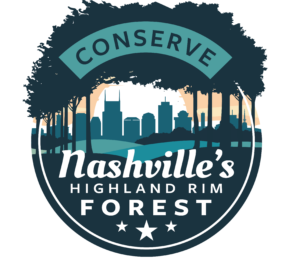
Nashville Highland Rim Forest Protection Project
Rising to more than a thousand feet in elevation, Tennessee’s Western Highland Rim arcs around Nashville’s west side. One of Tennessee’s nine physiographic provinces, the Rim is characterized as the most heavily forested region in the state. In recognition of its ecological importance, the Western Highland Rim Forest (WHRF) is one of the designated Conservation Opportunity Areas (COA) in Tennessee’s State Wildlife Action Plan (SWAP) and contains the ecosystems on which Swan Trust has been focused since its founding in 1992.
The U.S. Fish & Wildlife Service (USFWS) applies layers of environmental data from The Southeast Conservation Blueprint (SECAS Blueprint) to identify priority areas where conservation action would make the biggest impact. They help the State identify these COAs, with the WHRF being one example. The portion of the WHRF within Nashville’s city limits is now recognized as Nashville’s Highland Rim Forest.
When USFWS focused more closely on the 127,000-acre portion of the WHRF in Nashville, they identified 97,000 acres as wooded and in need of prioritized protection. Having a continuous forest of this scale reputedly brings the distinction to Nashville of possessing what may be the largest urban forest in the world.
Gems such as Radnor Lake State Park, Warner Parks, West Meade Hills, Bell’s Bend Park, Beaman Park, and Whites Creek provide public recreation opportunities and abundant wildlife habitat, along with essential ecosystem services – cooling and purifying the air of urban heat islands; sequestering carbon in trees above and soils below ground; acting as a forest floor sponge to slow heavy rains and absorb potential flood waters; providing rich and abundant floral and faunal habitat.
For now, this forest is still mostly intact, but it is threatened by Nashville’s exploding population growth, speculation, development, and aging landowners, all of which are fragmenting the centuries-old forests amongst developed areas.
As “islands,” stand-alone parks are increasingly surrounded by asphalt and development, threatening loss of their biodiversity due to size, limiting migration corridors, and creating edge effects.
To assist in connecting protected forests, Swan Trust has joined forces with more than a dozen local organizations in Nashville, forming The Alliance to Conserve Nashville’s Highland Rim Forest. The goal is to identify and conserve key properties through acquisitions or conservation easements. Swan Trust’s mission statement clearly aligns with preservation and protection of Nashville’s Highland Rim Forest. Holding smaller conservation easements on private lands is a role that we will play to support this initiative.
Metro Nashville’s Planning Commission must help fund land conservation to realize its NashvilleNext vision of preserving our local habitats for future generations. It’s a race to conserve these forests. The time is now.
